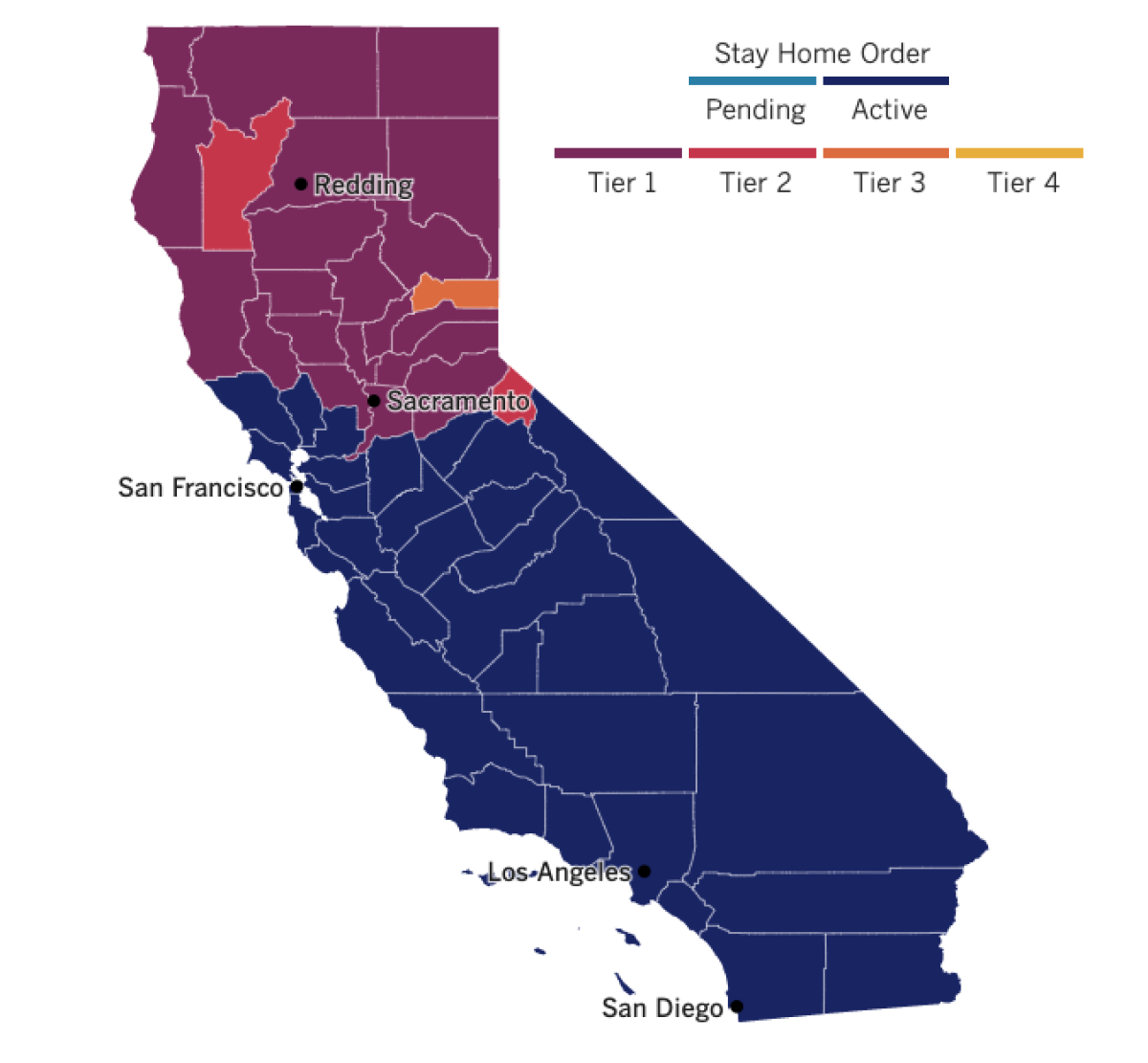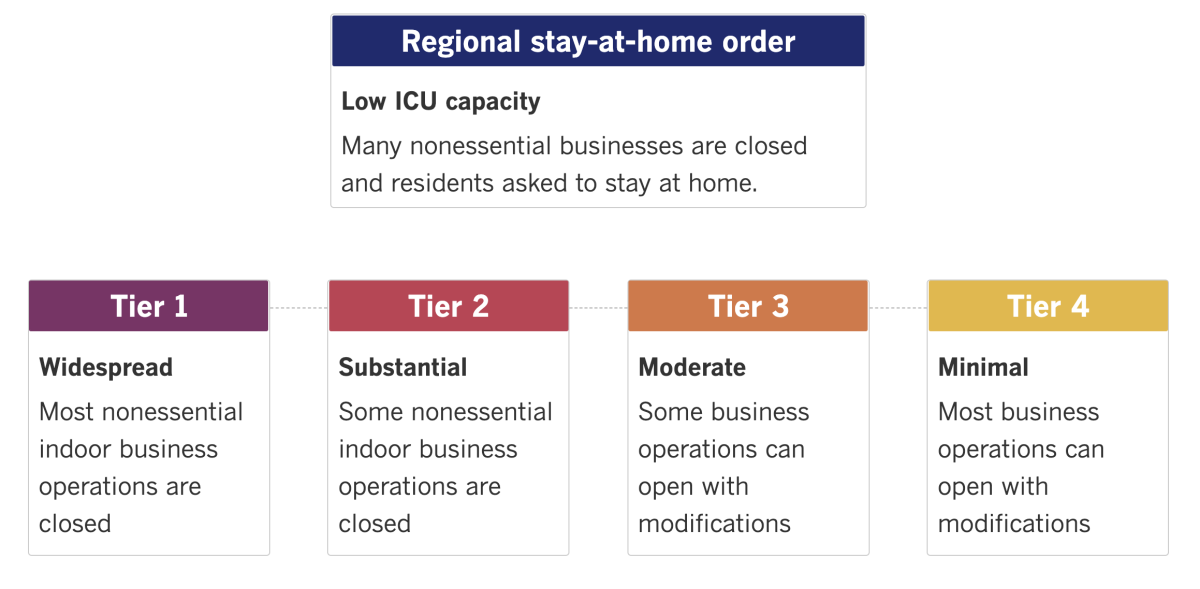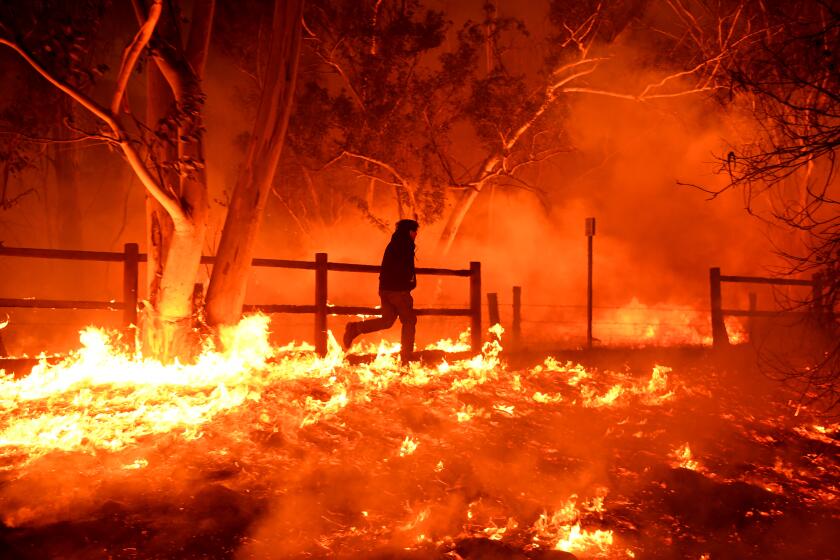Coronavirus Today: Masking up at home
- Share via
Good evening. I’m Amina Khan, and it’s Tuesday, Jan. 12. Here’s what’s happening with the coronavirus in California and beyond.
No one wants to think about choosing the final words to say to a dying loved one. Even worse is having to choose these two words: “I’m sorry.”
But that’s exactly what healthcare workers are witnessing as critically ill COVID-19 patients speak to their family members — often via a screen because it’s too dangerous for them to come to the hospital. Adult children are apologizing to their elders for bringing the coronavirus to them.
“One of the more heartbreaking conversations that our healthcare workers share is about these last words when children apologize to their parents and grandparents for bringing COVID into their homes for getting them sick. And these apologies are just some of the last words that loved ones will ever hear as they die alone,” Los Angeles County Supervisor Hilda Solis said. “Please, for your loved ones, stay home. Stay safe. Keep your loved ones alive.”
The current spike in infections — and the resulting increase in hospitalizations and deaths — was driven in part by family gatherings around Thanksgiving and Christmas, health officials say. These gatherings allowed younger people, who were more likely to be out and about, to spread the coronavirus to their elders, who tended to stay home.
Some younger folks may have to work essential jobs that expose them to others. Other young people may have felt less worried about the risks of getting together because even if they’re infected, they’re less likely to experience the worst symptoms, if any at all. But the same virus that might manifest as a minor cold in a young adult can ravage the body of a senior citizen, especially one who is already battling a health condition such as Type 2 diabetes or coronary artery disease.
These were exactly the kinds of scenarios that public health officials feared when they urged Angelenos not to gather for the holidays.
There’s also been a recognition that much of the region’s devastating spread now seems to be happening through households, which may no longer be considered safe spaces for everyone who lives within them. That’s one reason why L.A. County authorities are now recommending that some people wear masks inside their own homes.
Barbara Ferrer, the county’s public health director, advised people who have to work outside the home or go out to perform essential tasks like grocery shopping to mask up at home if they live with someone who is elderly or has an underlying medical condition.
“Because there is so much spread, we’re also recommending that people keep their face coverings on while they’re inside the home,” Ferrer said Monday. For anyone who works outside or is the person who runs the essential errands in the family, wearing a mask at home “will just add a layer of protection while we get through the surge.”
People should also make sure to sanitize all frequently touched surfaces, refrain from sharing utensils and, if possible, make sure that bedrooms and bathrooms are not shared with the most vulnerable.
“This is the time to be extremely cautious and very careful,” Ferrer said. “We cannot lighten up our efforts yet — not now, and not for the next several weeks. Every minute, 10 people in L.A. County on average are testing positive for COVID-19.”
By the numbers
California cases, deaths and vaccinations as of 5:13 p.m. PST Tuesday:

Track the latest numbers and how they break down in California with our graphics.
Across California
The happiest place on Earth might soon bring a different kind of joy to some Southland residents. Health officials are set to begin distributing COVID-19 vaccines at Disneyland, making the resort the first “super” vaccination site in Orange County. County officials said the theme park will be one of five large sites that together would be able to administer shots to thousands of people each day.
Most folks who are eligible for the vaccine, starting with high-priority groups like people who work in healthcare and at long-term care facilities, will be contacted through their employer to set up an appointment. Walk-ups will not be accommodated, and vaccine recipients must show identification and proof of eligibility. Residents are urged to visit the OC Health Care Agency’s website to determine when they’d become eligible. Anyone trying to obtain a shot ahead of schedule, officials said, “will overload the system.”
In Los Angeles County, officials have expanded their vaccine eligibility list in an effort to speed up the rollout and ensure that leftover doses are not wasted. Now, all healthcare industry workers can receive vaccinations, including staffers at urgent and primary care clinics, research laboratories, pharmacies and dentist offices.
The county plans to vaccinate half a million more healthcare workers by the end of the month, and intends to open five more vaccine distribution sites starting Jan. 19. Additionally, Los Angeles Mayor Eric Garcetti said Sunday that Dodger Stadium would transition from a coronavirus testing site to a COVID-19 vaccination site.
As of Monday, 180,174 vaccine doses had been administered in the county, including 25,840 second doses. That’s a fraction of the 490,995 doses the county had received by Wednesday. Across the state, less than a third of the doses that have been shipped to California have been administered.
The shots are desperately needed, as L.A. County is closing in on 1 million confirmed coronavirus cases — a devastating milestone that means 1 out of every 10 Angelenos has been infected since the start of the pandemic. The caseload is growing exponentially: While it took the county nearly 11 months to register its first 500,000 cases, it will likely take just one month to rack up the next 500,000. Officials expect that to happen by the end of this week.
So it’s more important than ever for residents to commit to infection prevention protocols, Ferrer said. “All it takes is one mistake and soon, five, 10 or 20 other people become infected,” she said. “This deadly virus continues to spread at alarming rates, and the most important way to stop it in its tracks is to avoid interactions with others and protect ourselves at all times.”
Northwest of Los Angeles, three coastal counties — Ventura, Santa Barbara and San Luis Obispo — are experiencing alarming spikes in their caseloads, with the average numbers of new daily cases more than double the rates from just two weeks ago, a Times analysis shows. It’s triggering fresh fears of overloaded hospital systems as doctors and nurses struggle under the weight of patients sickened by, and dying from, COVID-19.
“I’m tired of having to talk to family members to tell them that their family member has passed away from this disease,” said Dr. Mark Lepore, who works in the intensive care unit at Ventura County Medical Center. “I’m tired of hearing about family members that are coming to the hospital way too late because ... they’re concerned that, when they go, they’re not going to come out alive.”
Meanwhile, a new report finds that pandemic-triggered job losses across the nation will leave tens of thousands of low-wage workers without homes. Los Angeles, which is already struggling with one of the nation’s largest homeless populations, will be especially hard hit because of its large low-wage labor force and high housing costs. Both of those factors also push people into crowded housing and make it easier for the coronavirus to spread.
The Economic Roundtable report bases its analysis on the effects of the 2008 recession and concludes that pandemic-related unemployment will trigger a brutal cycle of homelessness, my colleague Doug Smith reports. The kinds of jobs most likely to disappear include those held by low-wage and underemployed workers in retail stores, restaurants and bars, child care, personal care, and even in nonprofit institutions.
While the uptick began as a trickle in 2020, it will triple this year and peak by 2023, the report says. By then, the number of additional working-age adults with no place of their own to sleep will hit more than 52,000 in Los Angeles County. Given that the county’s 2020 count put the number at just over 66,000, it means the pandemic would increase the county’s homeless population by nearly 80%.


See the latest on California’s coronavirus closures and reopenings, and the metrics that inform them, with our tracker.
Consider subscribing to the Los Angeles Times
Your support helps us deliver the news that matters most. Become a subscriber.
Around the nation and the world
In Washington, two more members of the House of Representatives who were whisked into a congressional lockdown while a violent pro-Trump mob invaded the U.S. Capitol have tested positive for the coronavirus.
Rep. Brad Schneider (D-Ill.) announced his test result on Tuesday. So did Rep. Pramila Jayapal (D-Wash.), who excoriated Republican members of Congress who refused to wear a mask when it was offered to them during the lockdown. “Too many Republicans have refused to take this pandemic and virus seriously, and in doing so, they endanger everyone around them,” Jayapal said.
The Capitol’s attending physician had notified lawmakers Sunday that they may have been exposed to an infected person in the room where they sheltered in place. Rep. Bonnie Watson Coleman (D-N.J.) said she tested positive the next day.
Amid widespread concern over the slow rollout of COVID-19 vaccines, the Trump administration unexpectedly moved Tuesday to speed up delivery of the shots. Health and Human Services Secretary Alex Azar announced several major changes to increase the supply of vaccines and expand both the age groups eligible to receive them and the places where people can get them.
One key change: Going forward, the federal government will base each state’s vaccine allocation in part on how successful it has been in administering the doses already provided. “If you are not using vaccines that you have the right to, then we should be rebalancing to states that are using that vaccine,” Azar said.
The government will also stop holding back the required second doses of the Pfizer-BioNTech and Moderna vaccines, which would essentially double the immediate supply. It is also urging states to begin vaccinating people in lower priority groups, including those age 65 and older as well as younger people with certain health problems that make them more vulnerable to a severe case of COVID-19.
Soon, proof of a negative coronavirus test will be required for anyone to fly into the U.S. from abroad, a rule for which airlines had pushed. Beginning Jan. 26, international travelers — including U.S. citizens returning home — will have to be tested within three days of leaving for the U.S. and provide written documentation of a negative result. Airlines must confirm the information before letting passengers board, according to the Centers for Disease Control and Prevention.
As many health experts have noted, however, a negative test result does not eliminate the risk of spreading the virus. Asymptomatic people who get tested may receive a false negative result — an issue that has come up with a test used in Los Angeles. People also might be infected soon after their test and unknowingly spread the virus to others, thinking they’re in the clear.
Your questions answered
Today’s question comes from readers who want to know: Will a COVID-19 vaccine reduce my risk of transmitting the virus?
A lot of folks are looking forward to the day when, protected by a vaccine, we can be free of masks and hug each other without worry. But that depends largely on whether the vaccines reduce the risk of transmitting the virus to other people — and so far, we don’t really know if that’s the case.
“Most vaccines that protect from viral illnesses also reduce transmission of the virus that causes the disease by those who are vaccinated,” the Food and Drug Administration explains here. “While it is hoped this will be the case, the scientific community does not yet know if the Pfizer-BioNTech COVID-19 Vaccine will reduce such transmission.” (The same goes for the vaccine developed by Moderna and the National Institutes of Health.)
The Moderna and Pfizer vaccines have been shown to prevent cases of COVID-19 — that is, to prevent people from getting sick with the disease. But because of the way the initial clinical trials were designed, researchers didn’t test whether the vaccines can stop people from transmitting the virus to others.
Here’s an example I ran by Dr. Marc Sala, a critical care and pulmonary specialist at Northwestern University Feinberg School of Medicine: A vaccinated person could be exposed to someone infected with the coronavirus. The virus might hang out in their respiratory tract for a period of time as it tries — and, due to the vaccine, likely fails — to get a better foothold in their system. During that time, they could potentially transmit the virus to another person, who might go on to develop COVID-19.
That’s why it’s important even for vaccinated folks to mask up and practice social distancing to protect other people until enough people have gotten their shots that we achieve herd immunity.
We want to hear from you. Email us your coronavirus questions, and we’ll do our best to answer them.
Resources
Practice social distancing using these tips, and wear a mask. Here’s how to do it right.
Watch for symptoms such as fever, cough, shortness of breath, chills, shaking with chills, muscle pain, headache, sore throat and loss of taste or smell. Here’s what to look for and when.
Need to get tested? Here’s where you can in L.A. County and around California.
Americans are hurting in many ways. We have advice for helping kids cope, resources for people experiencing domestic abuse and a newsletter to help you make ends meet.
For our most up-to-date coverage, visit our homepage and our Health section, get our breaking news alerts, and follow us on Twitter and Instagram.




